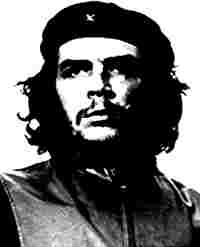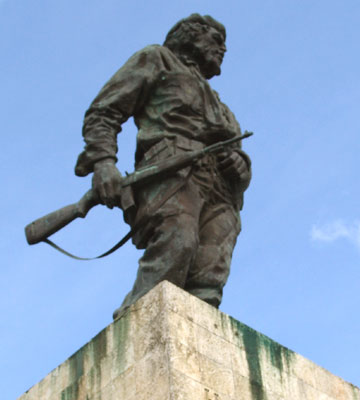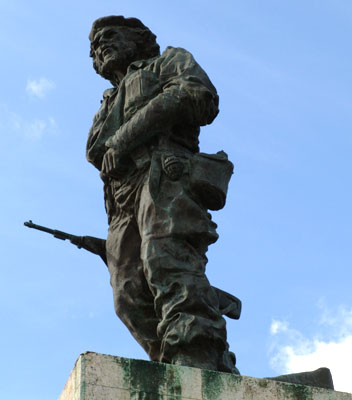|
 Ernesto Che Guevara Ernesto Che Guevara
Alberto Korda
The man who made Ernesto Che Guevara an icon, his image of Che Guevara became one of the most famous pictures of the 20th century Cuban photographer Alberto Korda,
who died on May 25, 2001 of a heart attack aged 72 while visiting Paris for an exhibition of his work, will be best remembered for his portrait of Ernesto Che Guevara.
One of the most famous photographs of the 20th century and one of the few that truly deserve to be called iconic.
Born in Havana on Sept. 27, 1928, the son of a railway worker, the young Mr. Korda had a variety of jobs before he started working as a photographer's assistant.
He was a runner for a bookmaker and a door-to-door encyclopedia salesman.
He took up photography with frankly macho motives: "My main aim was to meet women," he once confessed.
"I wanted to be near beautiful women."
He succeeded by marrying Cuba's most beautiful model of the day, Niurka, although his three marriages ended in divorce.
Naturally charming and ebullient, the diminutive and wiry Mr. Korda soon established himself as a successful fashion photographer,
changing his surname from Diaz Gutierrez to that of the British filmmaker Alexander Korda because it sounded like "Kodak" to his Cuban ear.
He soon had his own studio in Havana and an expensive playboy lifestyle.
Like so many of his compatriots, his life was transformed by the Cuban revolution of 1959.
On an assignment in the countryside soon after the guerrillas defeated dictator Fulgencia Batista, he encountered such poverty that he was converted to the revolutionary cause.
He began to follow the new Cuban leaders around, offering his photos to the newspaper Revolucion, whose offices were close to his studios.
He spent 10 years as Fidel Castro's official photographer,
using his skills to humanize the revolutionary leader's image in off-duty scenes,
sharing moments with Ernest Hemingway and Jean-Paul Sartre, or confronting a caged tiger at the New York Zoo.
It was while on an assignment for Revolucion in 1960 that Mr. Korda took the famous photo of
Mr. Guevara at a protest rally after a Belgian freighter carrying arms to Cuba was blown up by counterrevolutionaries while being unloaded in Havana harbour,
killing more than 100 dock workers. As he later recalled, it was a damp, cold day.
Using a 90-millimetre lens, he was panning his Leica across the figures on the dais when Mr. Guevara's face jumped into the viewfinder.
The look in Che's eyes startled Mr. Korda so much that he instinctively lurched backward,
and immediately pressed the button: There appears to be a mystery in those eyes, but in reality it is just blind rage at the deaths of the day before, and the grief for their families.
Ironically, Mr. Korda's picture was relegated to an inside page of Revolucion, which gave pride of place to Fidel Castro.
The original remained on the wall of Mr. Korda's studio until 1967, when he gave two eight-by-10 prints of it as a gift to the left-wing Italian publisher
Giangiacomo Feltrinelli the man who first published Dr. Zhivago in the West and who was blown up by a car bomb in 1972.
A few weeks later, Mr. Guevara was captured and killed in Bolivia and became an instant martyr.
When Fidel Castro addressed a memorial rally in Havana's Plaza de la Revolucion,
Mr. Korda's photo was used as a mural on the building facing the podium. It is still there. Mr. Feltrinelli instantly spotted the value of the image,
using one print for the cover of Mr. Guevara's diaries and giving the other to the makers of the posters that were soon being carried through the streets of Europe in the protest marches of 1968.
This image of Mr. Guevara, noble and defiant, with tilted beret and flowing locks, rapidly spread to T-shirts and album covers and was soon taken up by advertisers targeting youth until it rivalled the Mona Lisa as perhaps the most replicated image ever.
But Mr. Korda received no royalties; Mr. Feltrinelli had used the photo without permission and even failed to credit Mr. Korda as the photographer.
In any case, Mr. Korda had no remedy until Cuba rejoined the international copyright convention in 1997.
Finally, angered when the image appeared in a Smirnoff advertisement in Britain, Mr. Guevara never drank he asked the Cuba Solidarity Campaign to help him sue Smirnoff's advertising agency,
Lowe Lintas, and the picture library, Rex Features, for infringement. By happy coincidence, he received the news of an out-of-court settlement on his birthday last year, during a visit to London for the Cuba,
Si! exhibition of photography at the National Theatre.
He immediately handed over an undisclosed sum to buy much-needed medicine for Cuban children.
A lifelong smoker and rum drinker, Mr. Korda told marvellous anecdotes of the ascetic revolutionaries. "Once, I had to take pictures of Che cutting cane with the workers," he said. "He made me work for a week cutting cane before he'd let me take a shot, he was hard that way."
 
Monument of Che Guevara in Santa Clara
From 1968 to 1978, Mr. Korda concentrated on underwater photography until a Japanese exhibition in 1978 stimulated international interest in his work.
From the early 1980s, he lived in modest semi-retirement, although he accompanied Mr. Castro on a recent visit to Venezuela and Mexico.
In 1999, he appeared in the pre-title sequence of Wim Wenders's documentary Buena Vista Social Club, rifling through photos from the heroic early days here is Mr. Guevara, for example, playing golf with Mr. Castro "Who won?" "Fidel, because Che let him."
which ends with an image of a demonstration outside the U.S. embassy that Alberto Korda called David and Goliath.
For some reason, Mr. Wenders fails to credit him.
Alberto Korda leaves two sons and two daughters.
Speaking in Havana late last year, he said: Life may not have granted me a great fortune in money, but it has given me the even greater fortune of becoming a figure in the history of photography.
|
|